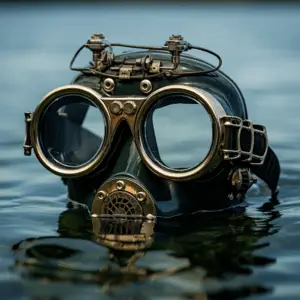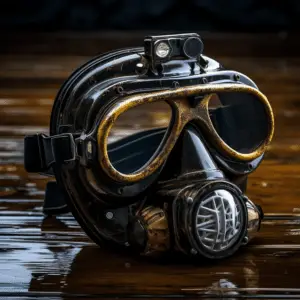When it comes to deep diving, having the right binoculars can make all the difference in your underwater exploration. Whether you’re a marine enthusiast or a professional scuba diver, binoculars for deep diving are essential for enhancing your underwater observation and ensuring a memorable experience.
Key Takeaways:
- Choosing binoculars for deep diving requires careful consideration of various factors.
- Lens quality and coating play a vital role in ensuring clear images and compatibility with low light conditions.
- Magnification and objective lens diameter impact the visibility of objects at different distances and light conditions.
- Waterproofing and fog-resistance are crucial features to protect the binoculars in underwater environments.
- Considering the weight of the binoculars helps prevent eye strain during prolonged use.
Factors to consider when choosing deep diving binoculars

Choosing the best binoculars for deep diving requires careful consideration of several key factors. One of the most crucial features to look for is the quality of the lens. A good lens ensures an aberration-free image with good contrast, allowing you to clearly observe underwater surroundings. It is also important to consider the compatibility of the lens with low light conditions, as this can greatly enhance your visibility during aquatic exploration.
In addition to lens quality, the lens coating plays a significant role in the performance of deep diving binoculars. A high-quality lens coating reduces reflected light, minimizing glare and enhancing light transmission. This is particularly important when diving in bright or sunny conditions, as it allows you to see more clearly and avoid eye strain.
Magnification and objective lens diameter are other critical factors to consider. Higher magnification is necessary for objects that are further away, such as marine life in the distance. However, it is important to note that binoculars with magnification above 12x tend to be heavier and may require the use of a tripod for stable viewing. The objective lens diameter determines the amount of light that enters the binoculars, with wider lenses being more suitable for low light conditions or underwater environments.
When it comes to diving gear, waterproofing and fog-resistance are essential features to ensure the longevity and performance of your binoculars. Regular binoculars are not designed to withstand prolonged exposure to water or fog, making them susceptible to damage and affecting your ability to observe underwater environments. Opting for binoculars specifically designed for waterproof and fog-resistant optics will give you peace of mind and enable you to fully enjoy your diving adventures.
Key Factors to Consider:
- Lens quality and compatibility with low light conditions
- Effective lens coating for reduced glare and improved light transmission
- Appropriate magnification for desired viewing distance
- Objective lens diameter for optimal light intake
- Waterproofing and fog-resistance for durability in underwater environments
| Factor | Importance |
|---|---|
| Lens quality and compatibility | High |
| Lens coating | High |
| Magnification | Medium |
| Objective lens diameter | Medium |
| Waterproofing and fog-resistance | High |
Lens quality and coating
The quality of the lens and its coating play a vital role in ensuring optimal visibility and image clarity in deep diving binoculars. When exploring the underwater world, divers rely on clear and aberration-free images to observe marine life and underwater landscapes. A high-quality lens ensures that the images seen through the binoculars are sharp, well-defined, and true to life. It allows divers to capture every detail, enhancing the overall diving experience.
To further enhance the quality of the image, the lens coating is equally important. The coating helps reduce reflected light, improving light transmission and minimizing glare. This feature is particularly crucial when diving in low light conditions, where capturing clear images can be challenging. The lens coating also protects the lens from scratches and other potential damages, ensuring the binoculars remain in excellent condition for extended underwater use.
Aberration-free image
An aberration-free image is essential for divers who want to explore the underwater world with precision and clarity. With a high-quality lens and proper coating, deep diving binoculars can deliver distortion-free images. This means that divers can see objects and details as they truly are, without any blurriness or distortions. Whether it’s observing colorful corals, fascinating marine creatures, or intricate underwater landscapes, an aberration-free image allows divers to fully immerse themselves in the beauty of the underwater realm.
Furthermore, these advanced lenses ensure good contrast, enhancing the visibility of darker areas in the water. This is crucial for divers exploring caves or diving during dusk or dawn when light conditions are limited. By providing a clear and sharp image, these lenses enable divers to make the most out of their underwater adventures, capturing breathtaking moments and enjoying an extraordinary diving experience.
Overall, when choosing deep diving binoculars, it is essential to prioritize lens quality and coating. These factors significantly impact the visual experience underwater, ensuring optimal visibility, image clarity, and compatibility with low light conditions. By investing in binoculars with high-quality lenses and proper coatings, divers can unlock the wonders of the deep sea and create unforgettable memories that will last a lifetime.
| Key Considerations for Lens Quality and Coating |
|---|
| High-quality lens for clear and aberration-free images |
| Proper lens coating to reduce reflected light and improve light transmission |
| Enhanced visibility and image clarity in low light conditions |
| Good contrast for better observation of darker areas in the water |
Magnification and Objective Lens Diameter
Finding the right magnification and objective lens diameter is crucial for deep diving binoculars to capture distant objects and provide optimal visibility in various lighting conditions. When selecting binoculars for deep diving, it’s important to understand how these two factors work together to enhance your underwater observation experience.
Higher magnification allows you to see distant objects with greater detail, making it easier to spot marine life or explore underwater features. However, it’s essential to consider that binoculars with magnification above 12x can become quite heavy, which may require the use of a tripod for stable viewing.
| Magnification | Recommended Use |
|---|---|
| 8x – 10x | Ideal for general marine observation and spotting marine life at close to medium ranges. |
| 12x – 16x | Great for observing distant objects such as ships or underwater formations. |
| 16x+ | Suitable for specific deep diving purposes or professional use, but may require a tripod due to weight. |
The objective lens diameter is equally important as it determines the amount of light that enters the binoculars. A wider lens diameter allows more light to reach your eyes, resulting in a brighter and clearer image, especially in low light conditions. Binoculars with larger objective lens diameters are beneficial for deep diving, as they provide better visibility in darker underwater environments.
Remember that while high magnification may seem tempting, it’s essential to consider the weight and stability of the binoculars, as well as the additional support they may require for steady viewing. Opting for a balance between magnification and objective lens diameter will ensure optimal performance for your deep diving adventures.
Summary:
- Higher magnification is ideal for observing distant objects, but may require a tripod to stabilize the binoculars.
- Opt for a magnification range of 8x to 16x for general marine observation and spotting marine life.
- Consider binoculars with a wider objective lens diameter for better visibility in low light conditions.
- Strike a balance between magnification and objective lens diameter to find the right combination for your deep diving needs.
Waterproofing, Fog-resistance, and Weight

When it comes to deep diving, binoculars need to be both durable and lightweight, with waterproofing and fog-resistance to withstand the harsh aquatic conditions. These features play a crucial role in ensuring clear vision and comfortable use during your underwater exploration.
Waterproof optics are essential for protecting your binoculars from moisture damage. When diving into the depths, your equipment is exposed to water, and regular binoculars may not withstand this environment. Opting for binoculars specifically designed for marine use will provide the necessary protection, allowing you to focus on your underwater observations.
| Features | Benefits |
|---|---|
| Waterproofing | Protection against water damage |
| Fog-resistance | Clear view even in humid conditions |
| Lightweight design | Reduced strain during prolonged use |
In addition to waterproofing, fog-resistance is another important feature to consider. Underwater environments often have high humidity levels, which can cause fogging on the lens of regular binoculars. Fog-resistance coatings prevent condensation from forming, ensuring a clear view and reducing the need for constant lens wiping.
Weight is also a crucial factor, as prolonged use of heavy binoculars can strain the eyes and lead to discomfort. Choosing a lightweight design will allow you to focus on your observations without unnecessary fatigue. Binoculars that prioritize eye relief and come with a tripod can further enhance your viewing experience, providing stability and reducing eye strain.
Conclusion
Choosing the best deep diving binoculars is essential for a successful and enjoyable underwater exploration experience. When it comes to selecting binoculars for deep diving, there are several crucial factors to consider. One of the most important features is the quality of the lens. A good lens ensures an aberration-free image with good contrast and compatibility with low light conditions.
The lens coating is equally significant, as it reduces reflected light and allows more light to enter the lens, resulting in clearer and brighter images. Magnification is another key consideration, with higher magnification needed for objects that are further away. However, it’s important to note that binoculars with magnification above 12x generally require a tripod due to their weight.
The objective lens diameter also plays a significant role in the performance of deep diving binoculars. Wider lenses allow more light to enter, making them more suitable for low light conditions. Waterproofing and fog-resistance are essential features to protect the binoculars from water damage and ensure clear vision in any outdoor environment.
Lastly, the weight of the binoculars should not be overlooked. Prolonged use of heavy binoculars can strain the eyes and impact the overall diving experience. Models that prioritize eye relief and come with a tripod can help reduce eye strain and enhance comfort during extended diving sessions.
FAQ
What factors should I consider when choosing binoculars for deep diving?
When selecting binoculars for deep diving, it is important to consider factors such as lens quality, lens coating, magnification, objective lens diameter, waterproofing, fog-resistance, and weight.
How does lens quality and coating impact deep diving binoculars?
Lens quality ensures clear images with good contrast and compatibility with low light conditions, while lens coating reduces reflected light and improves light transmission.
What is the significance of magnification and objective lens diameter in deep diving binoculars?
Higher magnification is needed for objects further away, and wider objective lens diameter allows more light to enter the binoculars, making them suitable for low light conditions.
Why are waterproofing, fog-resistance, and weight important features in deep diving binoculars?
Waterproofing and fog-resistance protect the binoculars in underwater environments, while weight affects the comfort of prolonged use during diving sessions.
